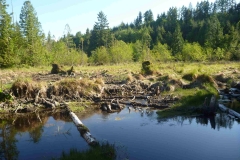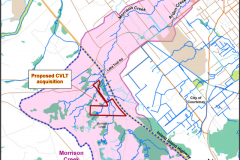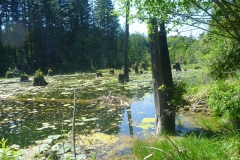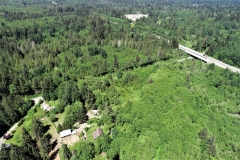This is the fourth in a series about how traditional municipal systems to handle urban stormwater runoff has affected Comox Valley streams, and the trend toward more natural solutions. The series examines and compares stormwater effects on three streams: Golf Creek, Brooklyn Creek and Morrison Creek.
Not all of the water from glacier-fed Comox Lake drains out through the Puntledge River. Huge volumes of cold clear water from the bottom of the lake infiltrate deep into the ground and begin seeping downhill on a multi-year journey toward the ocean.
But just east of Bevan Road, at the foot of a steep slope dropping about 100 feet, some of this water resurfaces in the form of dozens of tiny springs wiggling themselves free of their underground routes. These waters pool up into wetlands and ponds and grow into little tributaries that eventually all come together in one main channel.
We call that channel, Morrison Creek.
Morrison Creek flows from these headwaters at the outer edge of Cumberland, down through rural Area C of the Comox Valley Regional District, running somewhat parallel to Lake Trail Road. Then it travels through the City of Courtenay and joins the Puntledge River at Puntledge Park.
Like Brooklyn Creek, the Morrison travels through three separate municipal jurisdictions. But unlike Brooklyn — and most certainly unlike the polluted and channelized Golf Creek — the Morrison is alive with aquatic life in its cool, clean water.
The creek supports four of the five species of salmon all the way up to its headwaters. There are ample trout throughout the system, and large freshwater mussels flourish here. It is also home to a strange creature called the Morrison Creek lamprey, a unique variation of the common Western Brook Lamprey found on the coast.
And the Morrison’s waters run plentiful and steady all year around.
So why is Morrison Creek so much healthier than Brooklyn or Golf creeks?
The simple answer is that the Morrison’s headwaters are pristine and intact, and where it travels through developed areas, the creek remains mostly natural with adequate riparian cover.
But there’s also another reason.
More than 48 stormwater outlets empty into Brooklyn and Golf creeks — about two dozen each. And from those outlets flow oils, pesticides, animal and human feces and a variety of heavy metals and chemicals, many of which are toxic to wildlife. Golf creek gets an excessive amount of contaminants after a heavy rain because it drains the downtown commercial area of Comox.
By contrast, there are only two stormwater outlets into Morrison Creek, both near its termination in Puntledge Park and none come from a commercial area.
Saving the headwaters
The key to Morrison Creek’s success as a healthy waterway is the natural state of its vast headwaters. But that’s also the greatest threat to its long-term survival.
The headwaters area was originally logged in the 1920s and again in the 1960s. If the new growth was logged again, it would inflict cumulative negative impacts on the creek and wildlife habitat.
When the Comox Valley Lands Trust (CVLT) completed a science-based conservation plan several years ago, the Morrison headwaters emerged as a top priority to acquire and conserve. Not only does the nearly 600-acre area support significant biodiversity, it also plays a critical role in sustaining water quality in the rest of the Morrison watershed.
The headwaters are bordered by the Inland Highway to its west, north by Lake Trail Road and west by Bevan Road. The land is mostly owned by Hancock Timber Resource Group, a logging company known as Comox Timber, with few exceptions:
There are homes on two small rural lots and two undeveloped properties, and a small piece of wetland purchased by the province during construction of the Inland Highway that was later protected at the Linton Conservation Area.
“We have a good creek. We’d like to keep it that way.”
There is also a 55-acre parcel privately owned since the 1960s by the late Beecher Linton. His family has agreed to sell the land to the CVLT and has given the nonprofit ample time to raise the $870,000 purchase price.
“The Linton heirs appreciate the natural value of the land and Beecher’s history on it,” Jan Gemmell, president of the Morrison Creek Stream Keepers, told Decafnation.
Although the CVLT and the stream keepers hope to ultimately preserve the entire Morrison watershed, the Linton property is a good start. It contains critical salmon habitat, many of the main creek’s tributaries and wetlands important to diverse wildlife.
“As much as the creek has been muddled around with in its lower reaches, the creek has a really good, continuous source of cool, highly-oxygenated spring water that doesn’t dry up in the summer,” Gemmell said.
The best way to preserve Morrison Creek, she said, is to let the headwaters land regrow.
Tim Ennis, executive director of the CVLT, said the Linton property resides in the Comox Valley Regional District, which contributed 35 percent of the purchase price, and will eventually manage it as a nature park.
“The remainder of the Morrison headwaters is in the Village of Cumberland,” Ennis said. “It will be harder to acquire because the village doesn’t have the resources to help as much as the regional district did.”
Threats from multiple jurisdictions
While logging or development of the Morrison Creek headwaters would be devastating, there are also other threats.
The creek flows through Roy Morrison Park, a 20-acre parcel managed by the City of Courtenay, but owned by the Nature Trust of BC with a covenant to ensure its long-term natural state. But much of what people think of as Morrison Park is actually school board property.
Recent attempts by the school board to close Ecole Puntledge Park Elementary have raised concerns about the possibility the district would someday sell the lands.
In the Arden Road area, a City of Courtenay Local Area Plan specifies 30 metre setbacks from the stream, where no development can occur. However some relaxation of this standard has occurred, Gemmell said.
Gemmell said there are also concerns about the rural and sparsely populated areas west of Powerhouse Road, which lies in Area C of the regional district.
If smaller lot development was allowed in this area, with accompanying paved roads, gutters and storm drains, it would negatively impact the creek.
“Even larger country estate lots, developments where a single large home is built, but the whole lot is cleared, drained and leveled, remove natural sponge areas and affect creek flows,” Gemmell said. “We have a good creek. We’d like to keep it that way.”
Alana Mullaly, the CVRD’s senior manager of planning and protective services, said the lands in and around Morrison Creek are designated “settlement expansion areas” in the Regional Growth Strategy. Both the RGS and the zoning within the settlement expansion areas establish a minimum subdivision parcel size of four hectares (approximately 10 acres), she said.
“Settlement expansion areas are intended as reserve areas for future growth needs of the municipal areas,” Mullaly told Decafnation. “Higher intensity development in these areas would only be permitted if and when they are incorporated into a municipal area, publicly serviced (sewer and water) and a local area plan with companion zoning is prepared.”
However, Morrison Creek is also protected under the Riparian Areas Regulation.
“We implement that provincial regulation using the development permit tool,” Mullaly said. “We are also looking at how to better protect species at risk, such as the Morrison Creek Western Lamprey, through the development permit tool (e.g. implementing the Species at Risk Action plans).”
Morrison supports biodiversity
Beavers make dams on many of the spring-fed tributaries of Morrison Creek in its headwaters. These dams create natural retention ponds that allow water to soak back into the ground and also prevent overflows after heavy rains or snowmelt.
That’s what man-made retention ponds attempt to do. They prevent rushes of water into the creek that could cause erosion and disturb fish spawning grounds.
More than 48 stormwater outlets empty into Brooklyn and Golf creeks. By contrast, there are only two stormwater outlets into Morrison Creek
And the steady flow makes biodiversity in the creek possible. Besides salmon, trout, mussels and lampreys, there are also Red-legged frogs, Great Blue herons and Pacific Sideband snails living in the riparian areas of the creek. Of course, beavers, deer, bears and other wildlife live in the headwaters.
Perhaps the most unusual species found in the stream is the Morrison Creek lamprey, a unique variation of the common Western Brook Lamprey found in streams along the coast. It is only found in Morrison Creek.
The first five years of the lamprey’s life are spent immersed in the silty bottom of the creek or its ponds. When it emerges, the Morrison lamprey metamorphoses into both parasitic and non-parasitic forms.
Stream keepers do their part
To keep any stream healthy requires a dedicated and active group of volunteers. The Comox Valley is fortunate to have a large number of stream keeper groups, all with a high level of expertise, who monitor local creeks and advocate for their protection.
The Morrison Creek Stream Keepers was founded in 1996. It has seven board members and about 20 to 25 active volunteers, and has done numerous in-stream improvement projects. They have removed a dilapidated wooden fish ladder and replaced it with a boulder-based riffle, which creates fish habitat. Major fish passage work has been done at Comox Logging Road, and the volunteers have created a pond in Puntledge Park and done annual smolt counts and collecting data on spawning fish.
The Morrison stream keepers contract out the expert design and technical work to Current Environmental, of Courtenay. Funds for the project have come from other environmental nonprofits. The City of Courtenay has not provided matching grants in the past, as Comox has done for the Brooklyn Creek Watershed Society.
What’s next
The Comox Valley Lands Trust has almost raised enough funds to complete the purchase of the Linton property, but not nearly enough to preserve the entire Morrison Creek headwaters. Nor have negotiations begun with Comox Timber for the remaining 500 or so acres.
But the CVLT is working with BC Lands Trust Alliance to advocate for taking the Gulf Island Natural Areas Tax Exempt Program province wide. The Gulf Island’s program is a pilot project that eliminates property tax on any portion of the property where a covenant is placed on its natural assets.
For now, Morrison Creek is thriving, and that status could be assured with the protection of its headwaters; a wilderness oasis unaffected by human disturbances about the size of Vancouver’s Stanley Park.
And there’s something else important about Morrison Creek that doesn’t often get mentioned. The origins of the creek, natural springs created by groundwater seepage from Comox Lake and Maple Lake, remind us of the interconnectivity of the greater Comox Valley Watershed, and how it all impacts not just creeks and streams, but also our drinking water and the various ways people enjoy our waterways.











